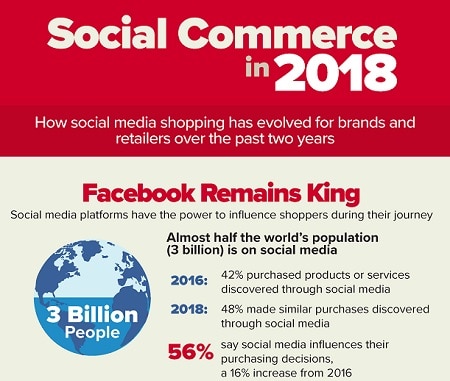
Earlier this year, Facebook was put under a microscope when the social media network’s data practices were called into question. This so-called “data scandal,” along with a few other issues, left some critics wondering if the social media giant could ever regain the trust of its one billion-plus users. But despite the controversy, Facebook has fared just fine. In fact, 67 percent of consumers still use the social network regularly—though the percentage has dropped significantly from 79 percent in 2016 (Instagram and Snapchat are the next most popular social media platforms with 38 percent and 25 percent, respectively.)
Consumers aren’t just using social media for recreation. These platforms also serve as useful tools for determining what to buy and where. Nearly half (48 percent) of all consumers say they’ve purchased products or services discovered through social media, a six percent increase in the last two years. Influence isn’t just limited to the discovery stage, however. Fifty-five percent of shoppers say social influences a purchasing decision, even if it’s not where the product or service is found.
With more and more consumers looking to social media for shopping inspiration, it makes sense that retailers are more invested in social media than ever before. But while social media can generate sales for a brand or retailer, social commerce, or shopping through a social media platform, has yet to gain traction among consumers. In 2016, only 10 percent of consumers had ever used a social buy button to purchase a product or service. In 2018, those numbers have hardly changed; 82 percent of shoppers still have yet to use a social buy button. Though Facebook’s data practice controversy may not have deterred consumers from using the platform altogether, the current state of social commerce suggests that they are wary of using it, and social media networks as a whole, to buy products and services. More than 70% of consumers cited security (credit card number, banking information, etc.) as a major concern, followed closely by privacy (personal information, shopping history, etc.) and legitimacy, or the validity in making a purchase via social media.
Though social commerce has yet to find its footing in the current market, the rise of emerging technology and its role in eCommerce could affect the way consumers view social media shopping. Chatbots, in particular, show promise as 37 percent of consumers have interacted with one before. While that number might seem low, nearly three out of four of those same consumers found their interaction to be helpful or informative. Despite the rise of chatbot usage, however, conversational commerce, or shopping through chatbots on messaging apps (Facebook Messenger, WeChat, etc.) still has a way to go, as 58 percent of consumers are familiar with the concept. Consumers remain open to chatbot usage as a whole, however, citing customer service and product comparison as their top potential reasons for using the technology.
While the current state of social commerce is at a standstill, the continuing influence of social media suggests could change the way shoppers currently view social commerce. As emerging technology like chatbots become more common, consumers will become more familiar with new ways to shop, and as a result, more open to shopping through social media.

Source: https://www.sumoheavy.com/
